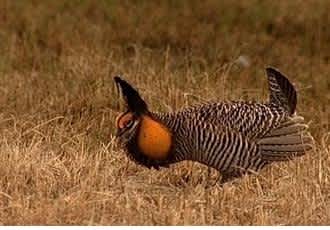Greater Prairie Chickens, Once Almost Lost, Whoop it Up in Minnesota
OutdoorHub Reporters 04.19.12

It’s that time of year again when birding enthusiasts flock to northwestern Minnesota to view, photograph and join greater prairie chickens on their “booming grounds” as they perform their spring courting ritual.
“It sounds like you’re listening to a chorus when you’re close to them,” said Ross Hier, assistant area wildlife manager for the Department of Natural Resources (DNR) in Crookston. “There’s really no good way to describe it; it’s best to experience it in person.”
httpv://youtu.be/vDLkQ5UqL-8
Prairie chicken viewing blinds have been installed in several locations by staff from the DNR area wildlife office at Crookston and the U.S. Fish and Wildlife Service (USFWS).
The chickens congregate in grassland areas called “leks” where males boom, flutter upward in the air, and stomp their feet in an effort to impress the females and stimulate breeding. Busily displaying their skills, males are best known for the melancholy “woooooo-oo” sound created by releasing air from their brilliant orange neck sacks. They also emit a variety of “true vocalizations” such as the very loud “whooooop” call. In concert with other males, courting sounds are very raucous and can be heard over long distances.
Opportunities to view the chickens are now a regular and welcome event, thanks in large part to grassland restoration efforts by the DNR, USFWS, The Nature Conservancy, and private landowners who enrolled in the Conservation Reserve Program (CRP) and/or keep native and tame grasslands on their property.
Over the past 40 years, such efforts have created large tracts of public and private grasslands that have helped return this native “prairie grouse” to its old haunts and build a stable population in northwestern Minnesota.
In 1910, prairie chickens occupied almost all of Minnesota, following behind the pioneers as they turned the forests into open grass and brushlands. However, by the 1980s, only 1,600 birds remained in northwestern Minnesota as changes to the landscape began to degrade prairie habitat, making it less desirable for the birds. This change was led by the reduction in grasslands as agricultural activities increased in size and intensity. In the former timbered areas, succession favored sharp-tailed grouse as brush habitats increased and eventually gave way to wooded habitat fit for ruffed grouse.
Prairie chickens were designated as a species of special concern in 1984, at which point most birds were restricted to a strip of grasslands in northwestern Minnesota, primarily in the beach ridge complex of Glacial Lake Agassiz, where large tracts of grasslands mixed with agricultural lands existed. Presently, wildlife managers estimate the prairie chicken population to be about 6,000-7,000, occupying a narrow range between Crookston and Fergus Falls.
The future of prairie chickens can be summed up in one word – grass – and lots of it, managed to remain vigorous and healthy. In many areas, however, grassland acreage continues to be converted to forestland through either planting or natural succession, or to large tracts of cropland.
The loss of CRP grasslands is most critical, Hier said. Today’s high commodity prices have resulted in a large decline in private grassland habitat over the last couple of years as landowners convert their CRP grasslands into croplands. This trend is expected to continue, greatly increasing the importance of enhancing, restoring and creating grassland habitat on publicly owned lands, such as DNR wildlife management areas and USFWS refuges.
“Prairie chickens and other wildlife can’t compete for land with commodities,” said Hier. “Managing for high quality grassland habitat on publicly owned property is now more critical than ever as we lose valuable grasslands to crops.”
Hier knows the future of greater prairie chickens and other prairie wildlife populations means protecting existing prairie grasslands, encouraging landowners to retain their grasslands, and using management tools such as prescribed burning, brush mowing and invasive species control to maintain and enhance existing habitat. To prairie chickens, his efforts mean the existence of critical nesting, roosting and booming-grounds habitat.
For those who enjoy viewing greater prairie chickens, habitat management and protection means having the opportunity to grab the binoculars and outdoor gear and hit the blinds for a little song and dance.
To reserve a viewing blind this spring, call the DNR area wildlife office in Crookston at 218-281-6063.
For additional viewing opportunities at the Glacial Ridge National Wildlife Refuge near Crookston and the Nature Conservancy’s Bluestem Prairie Preserve near Glyndon,
visit http://www.nature.org/Minnesota.
For more information on greater prairie chickens, visit www.dnr.state.mn.us/rsg.

